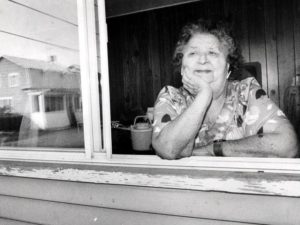 Here’s another Badass Woman I’d like to tell you about. Mary Two-Axe Earley was a Mohawk from Canada who fought for the rights of Aboriginal women.
Here’s another Badass Woman I’d like to tell you about. Mary Two-Axe Earley was a Mohawk from Canada who fought for the rights of Aboriginal women.
Mary Two-Axe was born on the Mohawk reserve of Kahnawake, Quebec, in 1911. She grew up there and in North Dakota, and when she turned 18, she moved to New York City, as many Mohawks did at the time.
In Canada, the Indian Act (first passed in 1876) determines who legally has status as a native person in Canada. Those who have status are often referred to as “Status Indians,” and they are recognized under federal law and have access to certain government programs and services.
(The word “Indian” is commonly used in this legal context because it is the word used in the actual law, but “Indian” is not generally used to refer to native people in other contexts.)
Back when Mary was a young adult, a status woman who married a non-status man lost her status under the Indian Act, and her children would not inherit status. The same was not true for men; a native man could marry anyone he wanted without losing his status, and his children could inherit status.
So when Mary met and married an Irish-American man, Edward Earley, she lost her status under the Indian Act. This meant she could no longer live or own land on a reserve, vote in elections, or be buried on the reserve. (A “reserve” in Canada is similar to a “reservation” in the U.S.) Additionally, her children would not have status.
For Mary, this meant that when she inherited a family home on the reserve, she was not legally permitted to own it or live in it. Luckily Mary’s daughter had married a Mohawk man, so the daughter was permitted to own the house. When Mary returned to this home to stay with her daughter, the council of Kahnawake tried to have her evicted.
She knew this wasn’t fair, so in the 1960s, she started lobbying to have the Indian Act changed to treat women and men equally. In 1968, the Royal Commission on the Status of Women recommended that the Indian Act be amended, but it wasn’t until 1985 that the government passed a bill to remove gender discrimination from the Indian Act. The bill also restored Indian status and membership rights to women who had lost their status and their children’s status by marrying non-status men. Mary was the first woman to regain her status. She was 73 years old.
She died in 1996, and as a Status Indian, she was allowed to be buried, as she had always wished, in the Kahnawake Mohawk Reserve.
Photo credit: Postmedia News




Leave a Reply